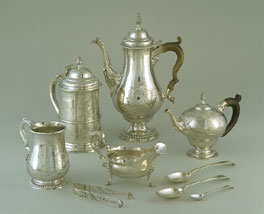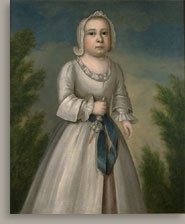 Joseph Badger
Joseph BadgerLois Orne (Mrs. William Paine), 1757
Description
Lois Orne is a three-quarter-length portrait of a young girl standing and facing three-quarters to the right, with her head turned forward and her blue eyes staring at the viewer. She wears a plain white cap with a narrow border that folds out from the head, framing her face and revealing her blonde hair. A pentimento above the cap suggests that it was originally drawn higher and rounder than its current low position and flat shape. There are gray shadows in the eye sockets, around the nose and mouth, and along the chin.
The girl’s posture is erect, and her proper right arm bends in front of her waist. In that hand she holds a gold whistle and bells. Her left arm hangs loosely by her side. Badger delineated the fingers and fingernails with dark-red lines. Gray shadows on the underside of the proper right hand and back of the left one help to model these elements. The proper right hand also casts a shadow on the girl’s dress, helping define the space.
The child wears a smooth, shiny white dress. The brushstrokes in the costume are the most fluid passages in the painting and create a lively play of light on the fabric, the folds of which are evoked with gray shadows. The dress, which has a curving neckline that begins low on the shoulder and crosses the chest in a gentle arc, is brightest along the proper right sleeve, the neckline, and in the front of the skirt. The sleeves end just below the elbow and have a broad cuff consisting of the same material folded back. The dress fits tightly in the bodice and flows outward from a seam at the waist into a wide skirt with soft folds. The neck and cuffs are trimmed with semitransparent white ruffles.
The brown background is dark and even to the child’s left, lightest immediately to her the right, and gradually darker toward the right edge of the composition. The upper-right corner is pale blue and probably has faded from its original intensity.
Biography
Lois Orne, born in Salem on February 18, 1756, and baptized there on February 22, was the fourth of eight children of Timothy (1717–1767) and Rebecca Orne (1727–1771).1 She was twenty-one months old when her father paid Joseph Badger for her portrait, which is her approximate age in the painting. Timothy Orne was a leading import merchant in Salem. During his career, he owned more than fifty vessels that sailed to the West Indies and Europe, carrying fish, cloth, wine, rum, brandy, grains, molasses, and slaves. Besides his trading ships, Orne owned vessels that supplied his other ships with Atlantic fish for trade.2 He was one of five founders of a "Civil Society" formed in 1745 for the "Preservation of Friendship & Conversation," and he was among the founding subscribers of Salem’s first library, established in 1760.3 Timothy Orne’s social standing is further demonstrated by his election to selectman of Salem in 1754. He died on July 14, 1767, leaving his daughters each substantial wealth: one-quarter of his dwelling, one-eighth of the adjoining lands, one-eighth of the barn and other outbuildings, two common rights in Salem, and 1,500 pounds lawful money.4
 |
|
| Figure 1. Paul Revere, Selections from The Paine Service, 1773, Worcester Art Museum. Dimensions provided are for height and length.
Depicted here, starting at left and moving clockwise, are: Teapot, h: 6 5/8 in. (16.8 cm), Gift of Richard K. Thorndike, 1967. Coffeepot, h: 13 in. (34.3 cm), Gift of Frances Thomas and Eliza Sturgis Paine, in memory of Frederick William Paine, 1937. Tankard, h: 9 5/16 in. (23.7 cm), Gift of Frances Thomas and Eliza Sturgis Paine, in memory of Frederick William Paine, 1937. Cann (one of a pair), h: 5 in. (12.7 cm), Gift of Frances Thomas and Eliza Sturgis Paine, in memory of Frederick William Paine, 1937. Tea Tongs, h: 5 3/8 in. (13.7), Gift of the Paine Charitable Trust, 1965. Butter Boat (one of a pair), h: 4 5/16 in. (11 cm); l: 7 1/2 in. (19.1 cm), Gift of Frances Thomas and Eliza Sturgis Paine, in memory of Frederick William Paine, 1937. Large Spoons (two of eleven extant), l: 8 3/4 in. (22.2 cm), Gift of Frances Thomas and Eliza Sturgis Paine, in memory of Frederick William Paine, 1937. Teaspoon (one of eleven extant), l: 5 3/16 in. (13.2 cm), Gift of the Paine Charitable Trust, 1965. |
Paine was a Loyalist, a political position that greatly complicated his family’s life during the next fifteen years. He was among fifty-two Worcester citizens to sign a protest against the "scandalous" Boston Tea Party, an act that resulted in his being labeled one of "five obdurate Tories." Because of his sympathies, Paine was forced to leave Worcester for England in 1774. He returned briefly but, on threat of hanging, soon left again for London. Lois remained with her father-in-law, Judge Timothy Paine, in Worcester during this time. Signing himself "one who loves you with the most ardent Affection," Paine asked his wife in 1775 if she would consider moving to England, but she never went.6 That same year, he received an M.D. degree at Marischal College, Aberdeen, and was appointed, on General William Howe’s orders, apothecary to the British forces in America. He served in the Carolinas, Rhode Island, and New York. Lois joined her husband in Newport and traveled with him to New York. In 1781 Dr. Paine went to England, where he was admitted a licentiate of the Royal College of Physicians in London, and to Portugal, where he served as Lord Winchelsea’s personal physician. In 1782 he journeyed to New York and then to Halifax, Nova Scotia, where he was appointed surgeon general to the English army. He was discharged in 1783.7
Paine was rewarded for his service to the British Crown with a pension of half pay and 5,000 acres at La Tête (now Frye’s Island) in Passamaquoddy Bay. There the Paines built a house, but Lois could not endure the isolation. As her husband noted in a letter, "My lands are certainly well located, and if Mrs. Paine could content herself, I should be very well pleased. Her objection is that the children cannot be properly educated."8 His spouse’s concerns apparently prompted William to petition Governor Thomas Carleton to establish an academy, which eventually became the University of New Brunswick.9 Next, the Paines moved to St. John, New Brunswick, where William held several public posts, including being elected to the Assembly of New Brunswick in 1785–86. When the ban against Loyalists was rescinded in 1787, the Paines moved to Salem and, after Dr. Paine’s father’s death in 1793, to the family home, The Oaks, in Worcester. The recorded births of Lois and William Paine’s children in Worcester (1774), Newport (1779), Halifax (1783), St. John (1786), and Salem (1788) show that Lois traveled with her husband throughout the tumultuous years of the American Revolution; a sixth child, born in 1778, died in infancy.
Lois Orne Paine died in Worcester on February 27, 1822, shortly after her sixty-sixth birthday.10
Analysis
Lois Orne (Mrs. William Paine) is one of six portraits Timothy Orne commissioned Joseph Badger to produce. The paintings were ordered in 1756 and completed in 1757, according to Orne’s account books.11 They included two larger (49 3/4 x 39 1/2 in.) three-quarter-length portraits of Timothy and his wife, Rebecca (location unknown), and four of the children: Rebecca (born 1748), Timothy (born 1750), Sarah (born 1752), and Lois.12 The portraits of Rebecca and Lois are in the Worcester Art Museum; the locations of the other two children’s likenesses are unknown. Rebecca’s portrait shows her at half-length, while Lois’s is a three-quarter-length image. This difference implies that Badger thought of his portraits in terms of the size of the canvas, not the format of the painting. Timothy Orne also paid the artist for "a Painted Highlander" and "a Painted Laughing Boy," which the Badger scholar Richard Nylander proposes might have been hand-colored European prints of genre subjects.13 Timothy Orne paid Badger six pounds each for the portraits of the adults, a total of five pounds five shillings for the four portraits of his children, and one pound one shilling for the two genre pieces.14 The portraits are listed in Timothy Orne’s probate inventory, along with another family portrait, at a total value of twenty-two pounds, sixteen shillings.15 Because of this clear documentation, the Orne portraits are the most important extant group by Joseph Badger and have long been regarded as benchmarks for other attributions to this artist.
More than one-third of Badger’s portraits represent children, a high proportion relative to his contemporaries. Perhaps this was because Badger successfully negotiated to paint individual portraits of entire families in several instances, including, in addition to the Ornes, the Brays of Boston (destroyed), and the Fosters of Charlestown, Massachusetts (National Gallery of Art, Washington, D.C.). He also painted several children in his own family, including his son (or grandson) Benjamin (about 1762, Winterthur Museum, Winterthur, Delaware) and grandson James (about 1762, Metropolitan Museum of Art, New York).16 The children are typically represented with a single attribute: a pet bird, squirrel, or dog; a flower or piece of fruit; or, in the case of infants, a rattle.
 |
|
| Figure 2. Joseph Badger, John Homans, 1755, oil on canvas, 30 x 25 in. (76. 2 x 63.5 cm), private collection. |
Lois Orne wears a cap, whereas her older sister’s head is bare. Women and children of both sexes wore caps, as is also demonstrated by the nearly contemporary Homans portrait. Lois’s dress resembles her older sister’s: both are satin with back closures and sweeping, rounded necklines that expose the upper part of the chest. The similarity of this toddler’s dress to Rebecca’s and to women’s garments of the period suggests that, even before her second birthday, Lois was being trained to stand and look like a genteel adult.18
Notes
1. Ellery and Bowditch 1897, I, 186.
2. Information on Timothy Orne’s ships is gleaned from the unpublished guide to the Orne Family Papers, Philips LIbrary, Peabody Essex Museum, Salem, Mass.
3. Phillips 1937b, 180.
4. Ellery and Bowditch 1897, I, 96.
5. Ibid., 189.
6. Dr. William Paine to Lois Orne Paine, August 12, 1775, manuscript, American Antiquarian Society, Worcester, Mass.
7. Ellery and Bowditch 1897, I, 96, 189, 190–91; Paine, 1878, 21–25; Chandler 1883, 240–42; Sibley and Shipton, XVII, 1967, 67–75; Carol Anne Janzen, "Paine, William," DCB VI, 1987, 563–65; Nutt 1919, I, 200–1.
8. Sibley and Shipton XVII, 1967, 72.
9. Montague 1992, 14.
10. Massachusetts Spy (Worcester), March 6, 1822.
11. Timothy Orne’s memorandum books are in Orne Family Papers, Phillips Library, Peabody Essex Museum, Salem, Mass. Payments to Badger are recorded October 27, 1756, and January 1, September 9, September 25, and October 17, 1757. Dresser 1972, 1.
12. The portraits of the parents were sold at Sotheby Parke Bernet, New York, October 25, 1973, Highly Important Eighteenth- and Nineteenth-Century American Paintings, sale no. 3561, lot 2.
13. Nylander 1972, 24.
14. Dresser 1972, 1.
15. Dresser 1972, 10.
16. Warren 1980, 1043–47.
17. Fales 1995, 58.
18. My perspective on the costume benefited from a conversation with the costume historian Claudia Brush Kidwell, May 3, 1999.